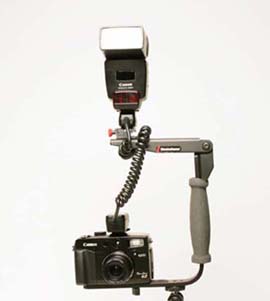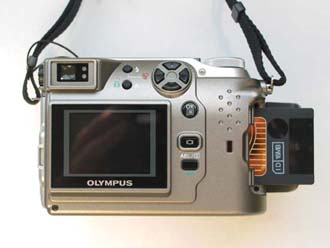3.16. Nighttime Photography
| < Day Day Up > |
3.15. Photographing ObjectsMost people usually photograph people and places. Every now and then, however, you'll need to photograph things: stuff you plan to sell on eBay, illustrations for a report, your personal belongings for insurance purposes, and so on.
The macro (close-up) mode of your digital camera makes it easy to shoot objects. All you need to do is set up and light your shot; the camera does the rest. 3.15.1. The Home StudioThe trick to lighting any object professionally, whether it's a painting or a teapot, is to position two lights, each at a 45-degree angle to the plane of the subject. At a hardware store, buy a couple of lamps. Sometimes called shop lights, they have clamps and ball joints to lock the lamp at a certain angle. Note: Buy lamps that accommodate regular lightbulbs, not the high- powered halogen models that melt everything within 50 yards. Regular 100-watt "soft light" bulbs work fine. While you're at the hardware store, look for some white butcher paper or some other paper that will give you a seamless background at least six feet long and four feet wide. (Camera stores also sell paper backdrops for about $30 a roll.) Now you're ready to set up your temporary photo studio. Slide a table against the wall, then hang your butcher paper about three feet above the table. Tape it to the top surface of the table, making sure that it has a gentle curve as it goes from vertical to horizontal. Place the item that you want to photograph in the center of the table, about a foot in front of the paper curve.
Next, it's time to set up your lights. You can use chair backs to clamp your lights, which should be pointing directly at your subject at a 45-degree angle, about three feet away from the subject, pointing slightly downward. Note: Some photographers eschew the two-light setup, preferring a bit of shadow on one side of the object. For this effect, use only one light; on the opposite side, create a reflective surface like a white piece of cardboard, aluminum foil, or white foam board. Make sure that the reflector bounces the light toward the object's non-illuminated side. Now your subject is evenly lit, with a minimum of glare and harsh shadows. Even though this homemade product rig might not look beautiful, the shots you create with it can be very appealing (Figure 3-17). Some other tips:
You're ready to shoot. 3.15.2. Natural Lighting for ObjectsOf course, you won't always be at home with a bunch of lights and roll paper at your disposal. Many of your object shots will be more spontaneous , impromptu affairs, or you may decide that a home studio isn't your cup of tea. In these cases, let nature provide the lighting. In taking natural-light shots like this, the trick is to keep your subject out of direct sunlight, which would create harsh contrast and "hot spots" on the object's surface. Instead, work in open shade , preferably in the morning or late afternoon hours when the light is the "sweetest." A north-facing window is perfect for this type of shooting. Once again, pay close attention to the background. You might have to get creative in setting up the shot so that it has a continuous background without any distracting edges. Finally, set the white balance controls to the Cloudy setting to offset the blue cast created by open shade. |
| < Day Day Up > |

